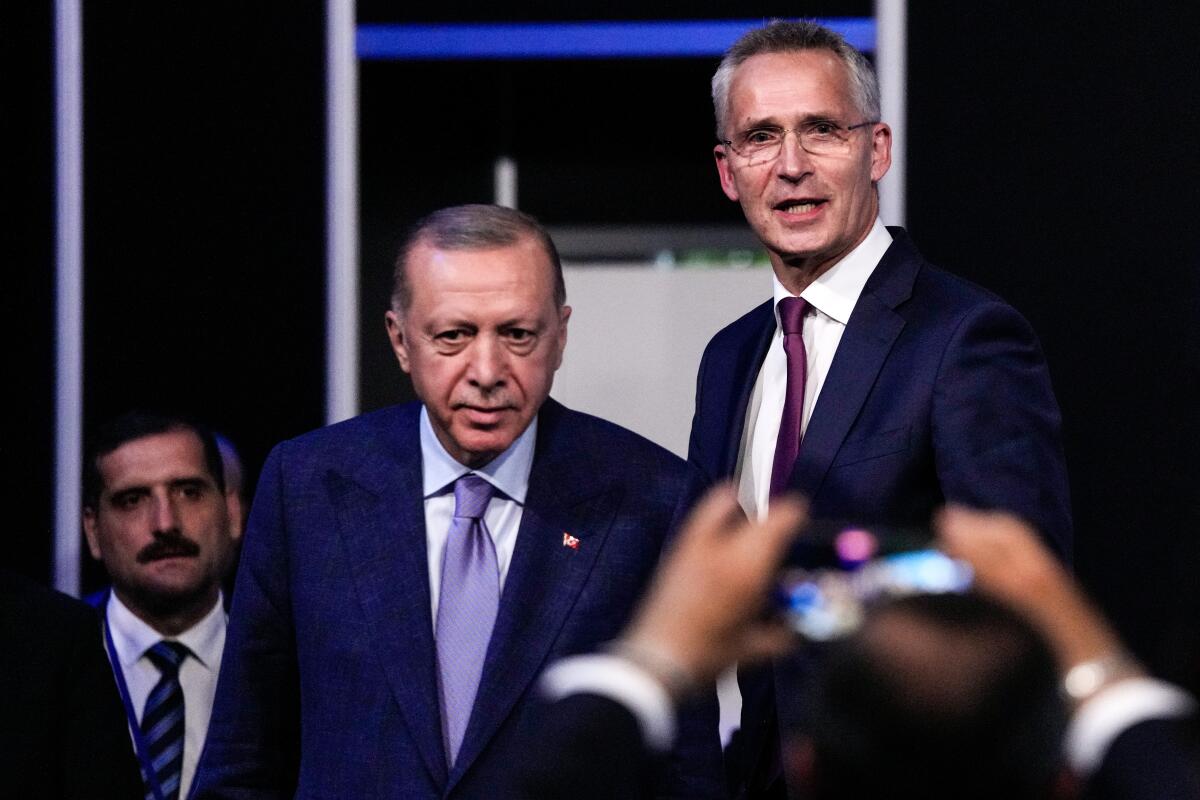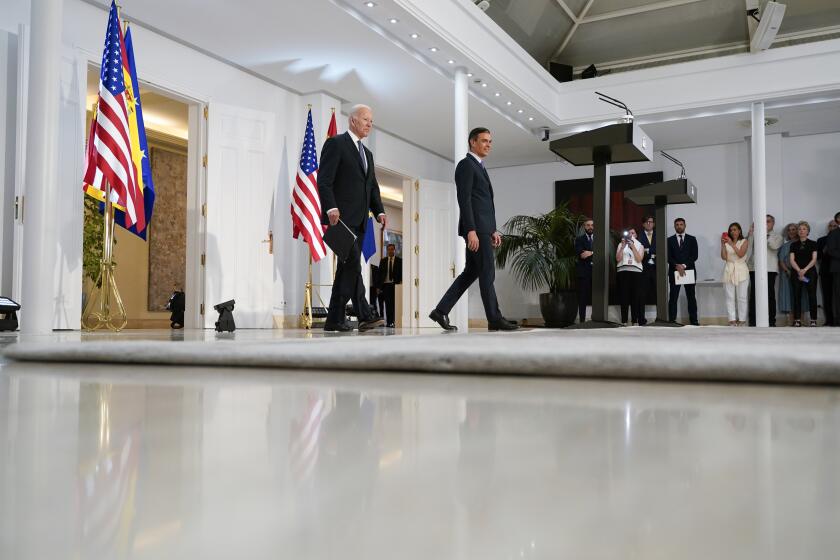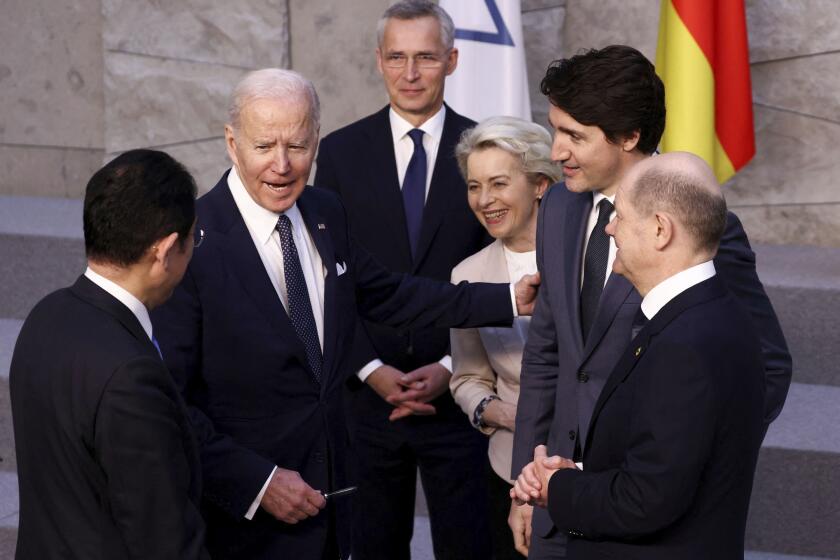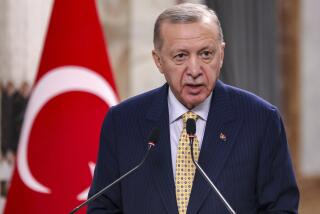So, why is Turkey in NATO, anyway? A look at the country’s complex history with the alliance

- Share via
WASHINGTON — Emerging from World War II, the North Atlantic Treaty Organization was established by 10 European countries, the United States and Canada to form a bulwark against the communist-ruled Soviet Union. It was a pillar in the new world order that was to last for the rest of the century and into this one.
In the years following World War II, Turkey found itself in a unique geopolitical position, at the crossroads of numerous civilizations, many of them at odds: Europe, Asia, the Middle East, the Caucasus. And sandwiched between the Black Sea to the north and the Mediterranean to the south.
Turkey felt empowered with that position — and vulnerable.
It was eager for protection and status. In 1950, Turkey dispatched its troops to support U.S. and United Nations forces repelling North Korea’s attempted invasion of the southern part of the peninsula, an action that won enduring praise from the West.
And so in 1952, Turkey joined NATO, hoping to bolster its aspiration to a Western identity and to ensure its security, especially against an ascending Soviet Union. It was the first expansion of NATO after its founding in 1949.
That makes the problems NATO is having today with Turkey all the more curious. Once fearing the Soviet Union, Turkey now is out of step with NATO policies in its friendliness with Moscow, buying Russia’s weapons and refusing to join U.S.-led sanctions against the Russian government.
Most of these shifts can be traced to Turkish President Recep Tayyip Erdogan, who was elected prime minister in 2003 and has not left power since.
The most recent obstacle that Erdogan threw in NATO’s path was his refusal to sign off on efforts by Sweden and Finland to join the alliance. The two Scandinavian countries see Russia’s invasion of Ukraine as a warning sign — Finland shares an 800-mile border with Russia — and have determined to abandon decades of strategic neutrality to become NATO’s 31st and 32nd member states.
Approval of new membership must be unanimous, giving Ankara power to block the deal. Erdogan maintained that his opposition was rooted in what he calls Swedish and Finnish tolerance of Kurdish activists who have fought his government politically or militarily.
Turkey accepts Sweden and Finland joining NATO as leaders tackle Europe’s worst security crisis in decades triggered by Russia’s attacks on Ukraine.
But on Tuesday, as a NATO summit was gathering in Madrid, the alliance’s secretary general, Jens Stoltenberg, announced that Turkey had withdrawn its opposition and Finland and Sweden would be able to pursue membership. However, Erdogan did not confirm that news publicly, and it was not clear what, if any, concessions he was able to extract in arriving at that position.
Concessions were the real goal, several analysts said — from NATO and especially the United States. The Biden administration has kept Erdogan at arm’s length over his human rights record, arrests of thousands of dissidents and journalists, and his intervention in Syria that slaughtered U.S.-supported Kurds and backed Russia and, ultimately, the government of Bashar Assad.
A Biden administration official said Tuesday that no concessions were granted.
“What Erdogan is trying to do is engage Biden,” said Bulent Aliriza, a founding director of the Turkey project at the Center for Strategic and International Studies, a think tank in Washington.
Erdogan had close relations with former President Trump, who declared himself a “big fan” of the Turkish president when he welcomed him to the White House in 2019. By contrast, President Biden has had a couple of telephone conversations with the Turkish leader — including one on Tuesday — and met him only on the margins of international conferences, as will happen at this week’s NATO meeting in Madrid.
Turkey has also sought to parlay the Russian war in Ukraine to its favor by showing NATO how it can be a valuable partner, despite its friendliness with Moscow. Members of the Erdogan family build and sell drones to the Ukrainian military. Erdogan has hosted peace talks, which have so far been unproductive, between the governments of Vladimir Putin and Volodymyr Zelensky, and is reportedly attempting to open Black Sea ports blockaded by Russia to free up Ukrainian grain exports.
The G-7 and NATO, which hold summits next week, have united in response to Russia’s war in Ukraine. But President Biden and other leaders arrive weakened by inflation and domestic issues, which may curtail the group’s ambitions.
“The invasion has been a window of opportunity” for Erdogan, said Gonul Tol, who heads the Turkey program at the Middle East Institute in Washington. “It has allowed him to attempt to rebuild the image of Turkey as a key NATO ally ... a valued partner, as opposed to a year ago when Turkey was portrayed as a Trojan horse in NATO.”
But, she warned, Erdogan could easily overplay his hand.
“Maximalist demands could undermine the goodwill,” Tol said.
Turkey was also the first, and until recently only, Muslim country in NATO. (Albania joined in 2009.) Before Erdogan‘s tenure, however, Turkey was steadfastly secular; women were actually barred from wearing head scarves in many venues. That also has changed in the nearly two decades of Erdogan rule. He is a devout Muslim, and he has introduced religion into public life in contravention to the principles of Turkey’s founding father, Mustafa Kemal Ataturk.
Though a religious government also goes against the grain in NATO, it is Turkey’s military ties with Russia that have most concerned the U.S. government and lawmakers in Washington, who demanded sanctions against Ankara.
Despite repeated warnings from Washington and NATO, Erdogan in 2019 purchased a large number of Russian-made S-400 surface-to-air missile systems. They are not compatible with NATO weaponry, and Western officials were worried that the purchases would give Russia access to NATO intelligence and equipment specs.
Turkey still looks to its NATO membership for “prestige, gravitas and panache,” said Sinan Ciddi, a Turkey specialist at the Foundation for the Defense of Democracies and a professor at the U.S. Marine Corps University. And NATO values Turkey as a buffer and “prime geostrategic real estate.”
Turkey, with one of the largest militaries in all of Europe, has also sent troops to Afghanistan, Bosnia-Herzegovina and Kosovo to back up U.S. and U.N. peacekeeping forces.
But, Ciddi said, Erdogan “can turn the tables on the United States and NATO.”
Earlier this month, Erdogan welcomed the disgraced crown prince of Saudi Arabia, Mohammed bin Salman, to Ankara less than four years after journalist Jamal Khashoggi was murdered at the Saudi Consulate in Istanbul, an act that U.S. intelligence says was ordered by Mohammed.
The killing provoked outrage throughout NATO, the U.S. and even Turkey at the time. But now Erdogan, facing dire economic conditions domestically and a potentially difficult election next year, must look for friends where he can, analysts say.
Erdogan’s relationship with Russia is complex, said Henri Barkey, a Turkey-born former State Department official who is now a professor at Lehigh University and adjunct senior fellow at the Council on Foreign Relations. For example: showing support for Ukraine but also needing Moscow to fight Kurds in Syria.
But in the end, “like Putin, Erdogan is his own worst enemy,” Barkey said, noting that his actions “undermine his credibility and they don’t trust him.”
More to Read
Get the L.A. Times Politics newsletter
Deeply reported insights into legislation, politics and policy from Sacramento, Washington and beyond. In your inbox twice per week.
You may occasionally receive promotional content from the Los Angeles Times.













